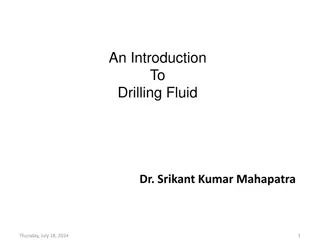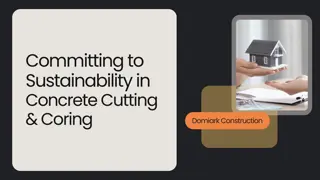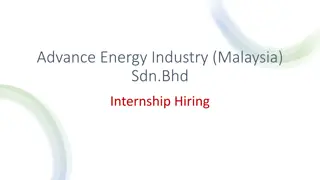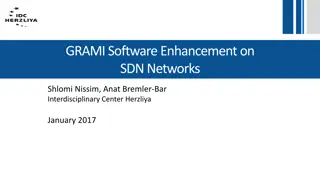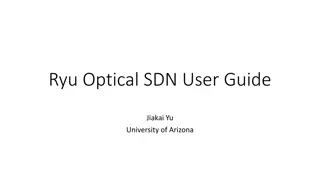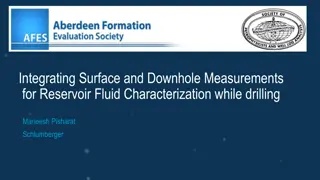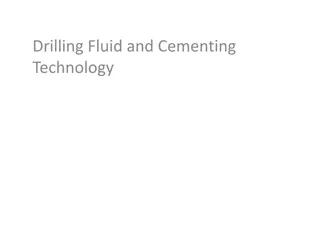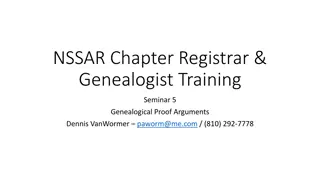Proof Coring Works for Micropiles: A Technical Briefing by SS Liew Foundtest Drilling Sdn Bhd
Proof coring is a common method to assess concrete/grout quality in cast-in-situ pile shafts or jet-grouted soil. This technical briefing by SS Liew Foundtest Drilling Sdn Bhd covers the methodology, equipment used, and technical issues related to proof coring for micropiles. The process involves drilling, obtaining core samples, and analyzing them for quality assessment, integrity, and optional strength testing. However, there are risks due to the small clearance space around the API pipe inside the micropile, which may lead to drilling accessories damage. Clients are advised on potential costs and responsibilities if drilling complications occur.
Uploaded on Oct 01, 2024 | 3 Views
Download Presentation

Please find below an Image/Link to download the presentation.
The content on the website is provided AS IS for your information and personal use only. It may not be sold, licensed, or shared on other websites without obtaining consent from the author.If you encounter any issues during the download, it is possible that the publisher has removed the file from their server.
You are allowed to download the files provided on this website for personal or commercial use, subject to the condition that they are used lawfully. All files are the property of their respective owners.
The content on the website is provided AS IS for your information and personal use only. It may not be sold, licensed, or shared on other websites without obtaining consent from the author.
E N D
Presentation Transcript
TECHNICAL BRIEFING ON PROOF CORING WORKS FOR MICROPILES Presented by, SS Liew Foundtest Drilling Sdn Bhd. http://drilling.my
INTRODUCTION Proof Coring is one of the method commonly used to determine the concrete / grout quality in cast in situ pile shaft or jet-grouted soil. By performing a proof coring, core samples of concrete or grout which is not visible underneath the ground can be obtained for observation in term of its quality, integrity and even tested for its strength (Optional Lab test). Proof Coring is carried out by performing a deep vertical drilling at desired point using a Drilling Machine and core samples would be obtained by using a Core Barrel.
The Equipment YWE D90R Boring Machine NMLC Core Barrel with Diamond Core Bit
Methodology 1. Drilling Machine would be set up on the desired point. 2. A NMLC Core Barrel (Core Sample is 54mm diameter) would be attached to the drilling machine for the core sampling purpose. 3. Once the vertically had been properly aligned, downward coring could be initiated at a controlled speed. 4. Core samples would be collected every 1.5m run, properly stored and labelled in a core box prepared. Core description, Recovery Ratio and RQD would be logged in a borelog as field record. 5. The engineers could visibly inspect the core samples or sent to the laboratory for compressive strength test.
Technical Issue The subject to core is the grout inside micropile API pipe of approximately 100mm inner diameter space using our core barrel of approximately 80mm outer diameter (Only left 10mm allowance space). The risk of damaging the coring accessories is high due to the unprecedented alignment of the API pipe underneath the ground up to the depth of 30m. A very minor inclination of the pipe could leads to collision of the core bit and API pipe of the pile. Therefore, client needs to agree with the clause to bear the cost of the drilling accessories if damaged (Specified in the quotation). If the coring path collides with the API pipe, further coring deeper is might be no longer feasible, and we do not responsible for the damage of the API pipe during the coring works.
The Micropile is as shown in the photo above. The Subject to core is the Grout inside the API pipe. Vertically of the pile underneath the ground could not be assessed.
Our NMLC Core Barrel with Diamond Core Bit is as shown in the left picture and the expected core samples is as shown below with 54mm diameter.
The Risk As mentioned earlier, the API pipe has a really small gap for our core bit to access. Therefore, it poses a high risk of collision between our core bit and the API pipe s internal wall. When this happens, there is a possibility that: 1. The bit would cut through the API pipe, damaging both the bit and the API pipe. 2. The bit would jammed inside the API pipe, unable to penetrate and damaged. Further coring downward also not longer possible. 3. The bit would lead by the API pipe to the bottom, without damaging the API pipe and the core barrel. We need to highlight all the possibilities so that each party would be clear on the cost and technical issue that might arise before we commence on the work. Photos shows previous Proof Coring Works done on bore pile whereby the core cut through the sonic logging tube installed inside the pile. The Core Barrel & Bit was damaged.









